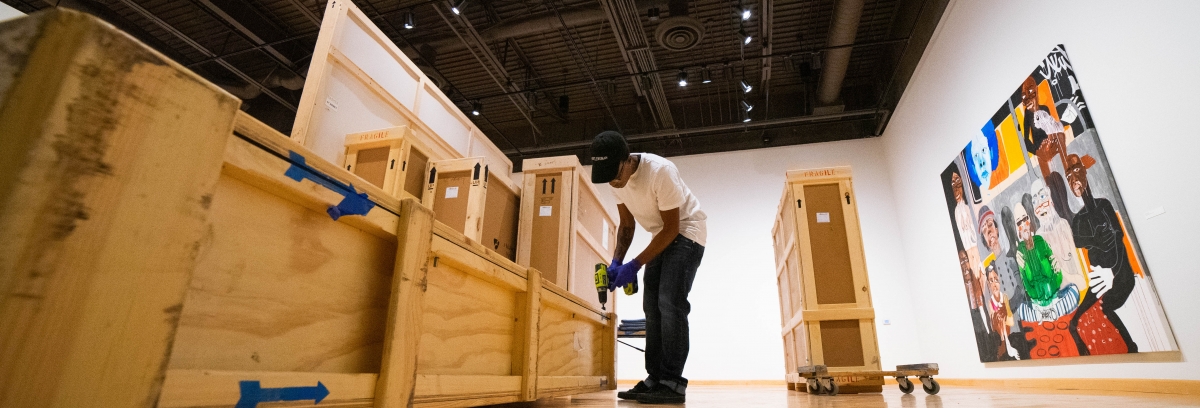亚慱彩票APP

FAQ
What is the program?
The Diversity Apprenticeship Program (DAP) is a new initiative by The Broad. It is made possible in part by the Institute of Museum and Library Services (IMLS). IMLS is a federal agency which provides library grants, museum grants, policy development and research.
The DAP provides full-time, paid apprenticeships in preparation/art handling. The program strives for equity within museum staff demographics. It addresses mid-level museum jobs and provides opportunities to apprentices from groups systemically marginalized on museum staffs.
What is a preparator/art handler?
A preparator or an art handler is someone who works directly with art or artifacts in museums, galleries and art shipping companies. Usually, they pack and unpack art, install and de-install exhibitions, and move art around museum and storage spaces. Their duties and skills are wide-ranging.
What are the program’s goals?
The DAP has two main goals. First, to train 16 apprentices in two groups. Apprentices will gain valuable skill-sets through hands-on learning. They will put their skills to work at several partner sites. Apprentices will give feedback to shape and improve the program.
Our second goal is to drive long-lasting, industry-wide change. We will create a toolbox to replicate our model at other organizations. The toolbox will contain: a learning curriculum, training materials, best practices for equitable hiring and inclusive work environments, performance metrics to measure success, and a manual of best art handling practices.
What makes this program unique?
There are notable programs addressing museum staff inequities. Yet, many limit these opportunities to students or recent high school/college graduates. Many of these programs also focus on academic, curator or entry-level opportunities.
Because a college degree is not required to take part in the DAP, it is accessible to a wider variety of people. The DAP provides new recruits or current entry-level staff a pathway toward higher paying, mid-level positions. The program brings together nonprofit, commercial and governmental partners. Our partnership will serve as a model for other public-private partnerships.
Who else is participating?
The Broad brought together the following partners in order to offer the apprentices a full scope of art handling experience: the Academy Museum of Motion Pictures, the Armory Center for the Arts, the Autry Museum of the American West, Building Bridges Art Exchange (a nonprofit gallery), California African American Museum, Cinnabar (a commercial fabrication company), Craft Contemporary, Crozier Fine Art Services (a commercial art logistics company), Grand Central Art Center (CSUF), Hauser and Wirth, the Los Angeles County Museum of Art, the Los Angeles County Department of Arts and Culture, Luckman Fine Arts Gallery (CSULA), Department of Cultural Affairs (City of Los Angeles)/Los Angeles Municipal Art Gallery, Museum of Latin American Art, RLA Conservation of Art and Architecture USC Fisher Museum of Art, and the Vincent Price Art Museum.
Why is the program focusing on preparators and art handlers?
The 2015 Andrew W. Mellon Foundation Art Museum Staff Demographic Survey highlighted a lack of diversity in many museum professions. For example, about 85% of preparators/art handlers are white. And over 75% of preparators/art handlers are male.
We realize the quickest way to effect change is to focus on these jobs, which do not require a college degree. At the same time, we know long-lasting change can only happen intentionally. An apprenticeship program like the DAP can serve as a model for other organizations to intentionally include those from systemically marginalized groups.
How does the program work?
The DAP is a nine-month, full-time, paid opportunity. To start, apprentices go through a month of training. They will learn what a preparator does and how to do it. This includes how to handle, install, and pack artwork and artifacts. They will then rotate to partner sites to do hands-on work. Apprentices will also go on field trips to museums and other cultural institutions.
By the end of the nine months, apprentices will be familiar with best preparator and art handling practices. They will gain the skills and confidence needed for careers in this field. Apprentices will also provide feedback on their experience, to help improve the program.
What can I do with preparator or art handling experience?
你可以做很多with preparator or art handling experience! Organizations of all types and sizes hire preparators: small community galleries, non-profit art spaces, large art and cultural institutions, private art handling companies, and art fairs to name a few. Preparator/art handling jobs can also lead toward higher-paid opportunities as head preparators, collections managers and other leadership roles.
Who can apply?
如果你喜欢使用你的手,在一起art, and are interested in using tools, building, and installing, this apprenticeship is for you. Art handling is a physical job. You must be able to lift 50 pounds, be comfortable working at heights over eight feet, and work on your feet for extended periods of time.
We will recruit applicants from the staff at our museum, our partner museums, and communities around Los Angeles.
You do not need to have any specific level of education or previous art handling experience. We encourage applicants from communities or groups systemically marginalized to apply. This includes African American, Latinx, Asian American, Native American and Pacific Islander, LGBTQIA+, socioeconomically disadvantaged communities, women, those who have been formerly incarcerated, and foster youth.
How much does the apprenticeship pay?
The DAP pays $16 per hour plus benefits.
How do I get more information?
Reach out to the DAP Program Manager, George Luna-Peña at 213.232.6260 orglunapena@thebroad.org.